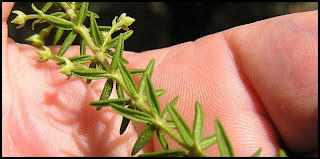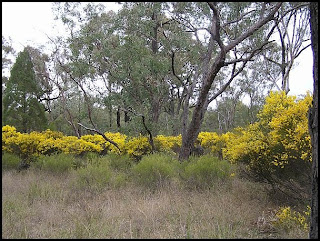 |
| Zieria aspalathoides |
Family - Rutaceae
Common name - Whorled Zieria
Flowers and fruit - 4-petalled flowers are pale to deep pink. Fruit has 4 segments. Flowering period is late winter to early summer.
Leaves and stems - Two groups of 3 leaves are whorled around the stem, with margins revolute (rolled under). When touched, the leaves have a strong smell. Branches are ridged.
Habit and habitat - Zieria aspalathoides is a neat shrub to about 1m, growing in sandy soil, often among rocks, in heath and sclerophyll forest.
 |
| The arrangement of leaves of Zieria aspalathoides |
 |
| The underside of the leaves with downward rolled margins |
 |
| 4-segmented fruit of Zieria aspalathoides |
 |
| Zieria aspalathoides growing in The Pilliga |






































